We’re Here, We’re Fun . . . Oops: Caporales in Cuzco

Brightly colored, energetic dancers bounding here and there, when they could, filled the Sun Avenue and the Plaza yesterday evening in a Salute from Qollasuyo to Cusco in its anniversary.
Mostly, the street and plaza filled with caporales, a dance based on the Afro-Bolivian saya. Created in 1969 by the Estrada Pacheco brothers, the dance builds on the personage of the overseer, the caporal with whips and boots and aggressive, athletic dancing who controlled African Bolivians for their boss. (Although seldom mentioned, he also represents the overseers who were responsible for controlling the Aymara and Quechua serfs who populated the many estates found in the Bolivian (and Peruvian) countryside prior to agrarian reform of the mid twentieth century.
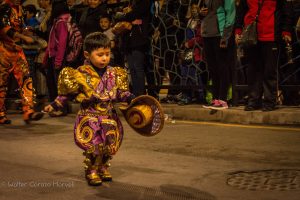
As a result, the dance performs a delightful and exciting turn-around. The grand children and great grand-children of the serfs (campesinos) have claimed that which used to belong the the Mestizos, the town and city dwellers that once governed and controlled their countries, even if there is a subtext of a work still to be done, the full recognition and valuation of African Peruvians and Bolivians.
This dance is not the parody of elites found in los doctorcitos, the wayra, or the siqlla, all of which satirize lawyers and mestizo elites from the position of people who are not those elites.
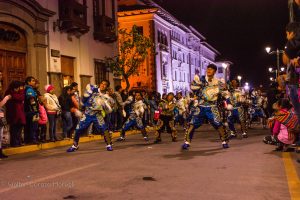
With its numerous aggressive young men showing off agility and athletic prowess, as well as their companions: young women in mini-pollers, svelte legs on display as they make their shortened skirt shift and turn in grace and erotic power, caporales is a dance that developed in the cities after urbanization had drawn young men and women from their communities to the exploding neighborhoods of Bolivian and Peruvian cities.

From when you first hear the music and then the bells on the legs of the men, even before you see the subtle yet confident and strong swirling of the young women’s skirts and the power of their shoulders and eyes or the prancing and jumping of the men in unity and rhythm, caporales grabs you and causes your heart to beat more loudly. It is as if human pheromones were floating in the air along with the music demanding attention and pleasure from all around.

Somewhere around two thousand dancers or more were bouncing and turning in the Sun Avenue last night in what seemed to be set up as a classic altiplano, high plateau, entrance where the dancers start and keep dancing along a course until the end.
However at the turn onto the Plaza de Armas the bloques (groups) all behind banners announcing their group name, got stopped in a massive traffic jam that soon had played its way down the Sun Avenue, with another jam right at the turn before the Cathedral and to the side of the reviewing stand.
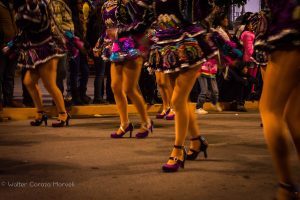
While many people in Cuzco join the bloques in order to participate and perform this exciting and fun dance, others grumble that these dances belong in Puno or La Paz, and not in Cuzco. They feel that in Cuzco people should only perform the dances that are registered as traditional and typical, the ones that are tightly controlled and codified for teaching in the schools and for public performance.
Some people wryly said that Cuzco should send its dancers to perform for the Virgen of Candelaria in Puno and see how the Puneños like it. What they miss, is that Puno is not sending these dances to Cuzco, rather people resident in Cuzco or people who are Cusqueños schedule them, practice them, and perform them in the Cusco where they reside as a sign of their being here and living here, at the same time they challenge the exclusivity of official culture.
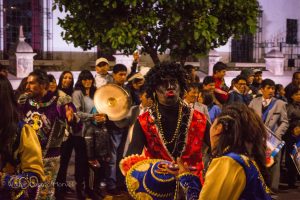
Another controversy swirls around this dance. While Puno performs it and other people adopt it in Peru, Bolivia has declared it Bolivian Cultural Patrimony and finds it wrong that Peruvians are dancing and now claiming what they hold is their culture.
This is a performance whose legitimacy is challenged on at least two sides. Yet it continues. It is dynamic, fun, and meaningful in the context of Cuzco.
This entrance to salute Cuzco is not the only time altiplano dances take place in Cuzco. This morning, as a write, a brass band playing a morenada, another popular altiplano dance, marched by the side of the plaza sounds pulsing strongly against the Plaza walls in the beat of altiplano feet.
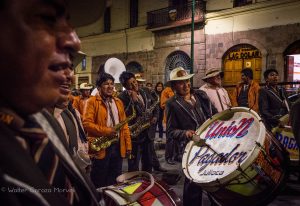
They are on their way to join the other devotees of the Virgin of Natividad who has just entered the chapel of Santa Catalina. Her ukukus are dancing in the church and Morenos, dancers of the morenada, are quickly putting on their costumes and gathering there to process with her.
Many of Cuzco’s saints are now accompanied by altiplano music and dances since people in Cuzco see them as means of organizing themselves and their devotion to the saints and to the social space of Cuzco.

This struggle is not new. It is rather one of long duration in this city in which the south eastern quadrant of the Inca Empire and the home of the Qollas, Qollasuyo starts and for which it is still a very important economic and symbolic center.
Nevertheless, Cuzco overwhelmed the dancers last night. It brought them to a standstill in what looked like forcing them into the EMUFEC model of staging dances before the reviewing stand as most important, followed by performances in the square on the other side of the plaza.
The Sun Avenue, instead of being the scene of a majestic entrance of Qollasuyo into the Plaza in a continuous flow, became a long staging ground whose focus was performance in front of the Cathedral. Still many troupes tried to perform on the Avenue as they went only to be frustrated into standing still while costumed.
The Caporal, as well as other altiplano dances, such as the diablada and the morenada are most likely in Cuzco to stay. The controversy will also continue, even as these dances draw ever more people with their dynamism.




